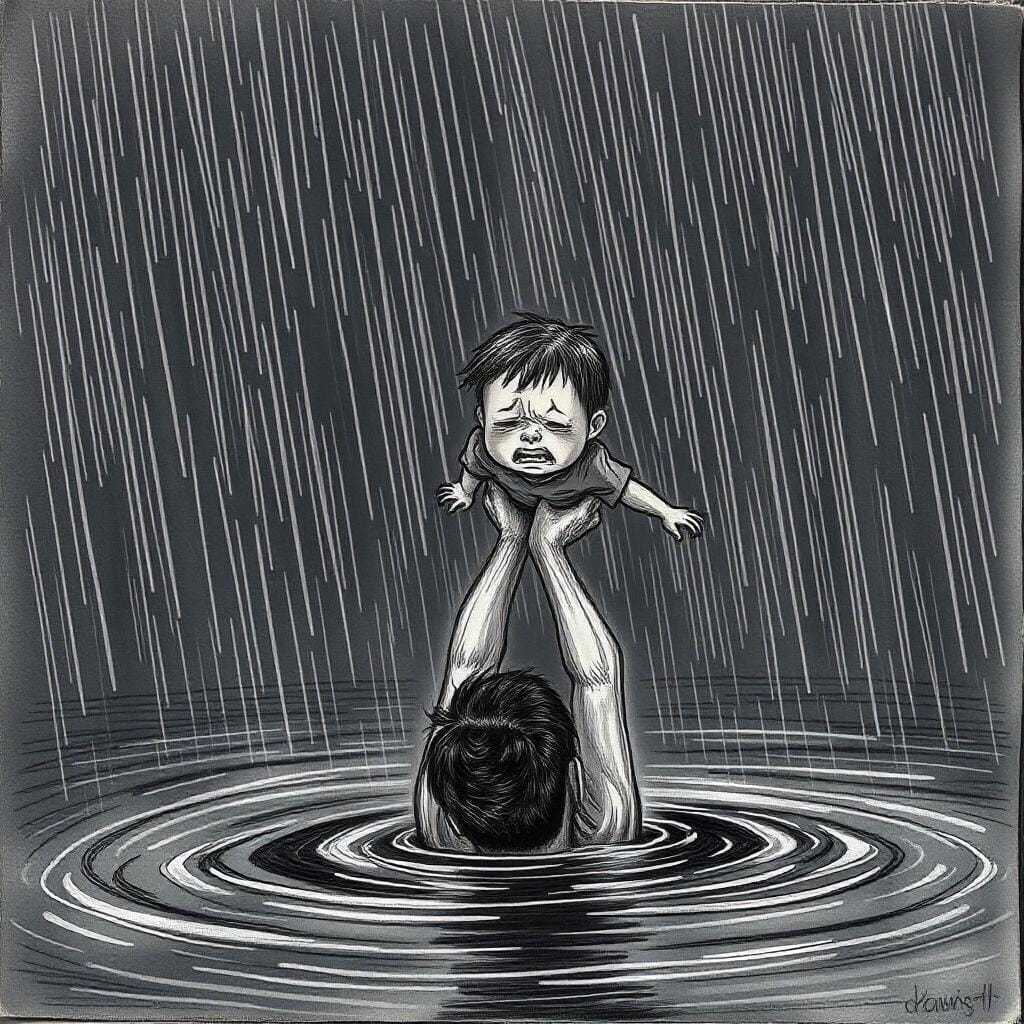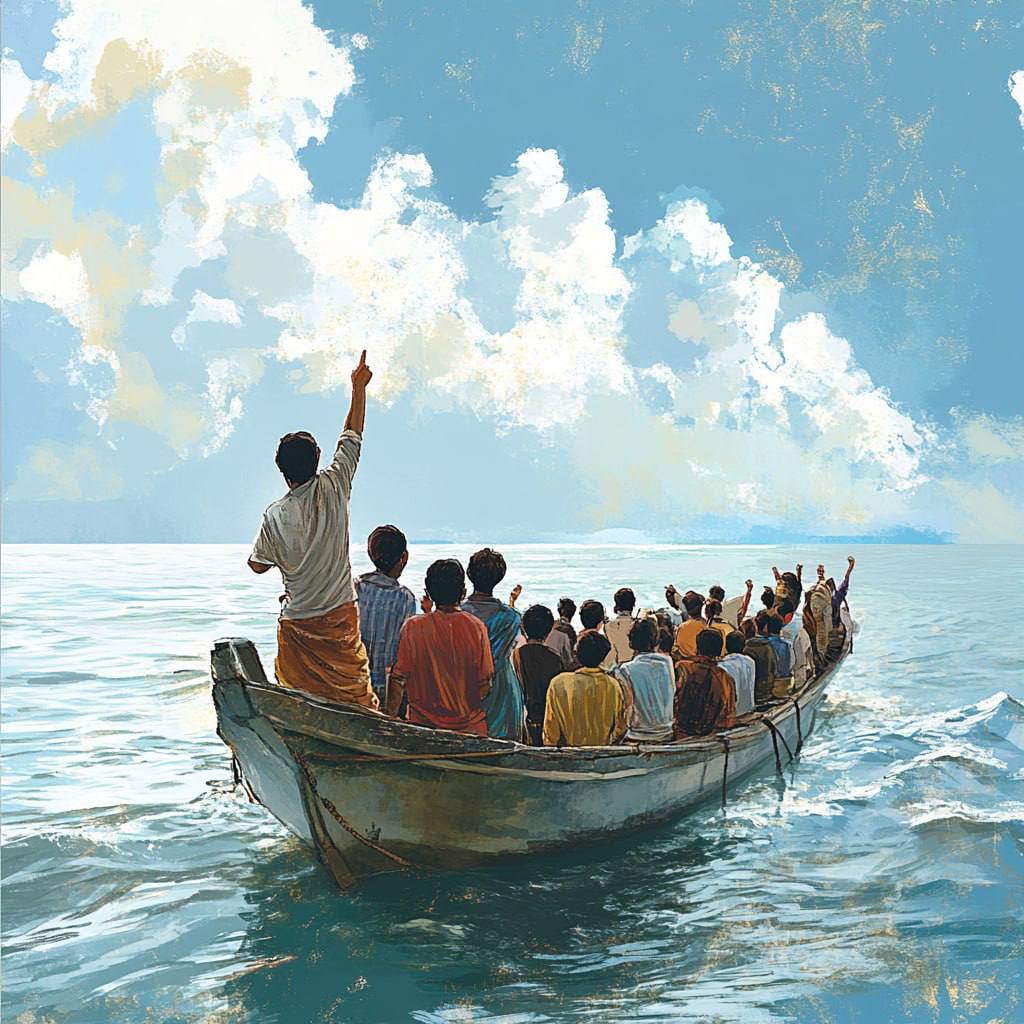
"Khin Ma Wai!" The deep, prolonged shout echoed just before the small house was swept away by the floodwaters.
In the raging current, a home drifted away, gradually carried off and dragged along. As the little house floated away, only the helpless cries of those who could do nothing but watch remained behind.
Although the video footage only showed this much, what happened to Khin Ma Wai or her family inside the drifting house became a scenario too painful for everyone to contemplate.
The flood videos that went viral on social media weren't just of Khin Ma Wai's house. Images of people desperately crying for help atop treetops and rooftops became overwhelmingly numerous between September 11 and 12. In social media videos, waters could be seen rushing into villages within a short time. The currents were strong, and the water level rose alarmingly fast. People, cattle, animals, and buildings swept away by the current disappeared beneath the waters in mere moments.
These weren't fictional scenes, but real situations where rescue couldn't arrive and escape was impossible. For the people of Myanmar, already struggling to breathe, these sights and events were like adding salt to a wound, bending them to the breaking point.
From Typhoon Ragi onwards
The Super Typhoon Ragi that hit Vietnam also affected Myanmar. As a result, from September 11, heavy rains fell across Myanmar, and many rivers and streams exceeded dangerous levels, causing flooding. Mandalay, Naypyidaw, Bago, Mon, Karen, Southern Shan, Eastern Shan, and Kayah (Karenni) experienced flooding. Particularly in inland cities, including Naypyidaw and central Myanmar towns, unprecedented flooding occurred.
Even in Naypyidaw, considered Myanmar's administrative territory, the death toll due to flooding reached 42. Misfortune, as they say, never comes alone. The flooding was accompanied by continuous landslides.
Near the Yamethin gold mining area, six villages experienced both flooding and landslides, resulting in nearly entire villages being submerged. The estimated death toll reached into the hundreds.
In Bagan, heavy rains caused parts of ancient pagoda walls, including the thousand-year-old Hsin Phyu Shin Pagoda, to collapse and fall.
Similarly, in Shan State's Inle Lake area, out of 445 villages, over 100 were submerged by September 12.
The situation in Kalaw, a town over 4,000 feet above sea level, was particularly tragic. In Kalaw, over 100 bodies were found due to flooding and landslides, with more than 200 people still missing.
On the Thai-Myanmar border, the rising waters of the Mae Sai River led to 11 deaths in Tachileik. Likewise, Kyaingtong experienced flooding and landslides. Karen, Mon, Myawaddy, Hpa-An, and Kawkareik areas also saw flooding. In Karenni State, flooding and landslides resulted in dozens of people being swept away and killed in mountain streams.
Before September 2024, Myanmar had already experienced two rounds of flooding.
On July 1, due to the rising Irrawaddy River, flooding and landslides occurred in Myitkyina, Chipwi, Waingmaw, Tanai, Hpakant, Sumprabum, and Injangyang townships, affecting over 10,000 people. In late July, Bago flooded again. Rising waters in the Sittaung and Bago rivers caused flooding in Bago Region, resulting in eight deaths and over 20,000 displaced. The Bago floods, lasting four days without receding, caused extensive damage and affected a large number of flood victims.
In August, Rakhine State and Tanintharyi Region also experienced flooding, though not as severe as in Myitkyina and Bago. Now, with the September floods, the death toll has exceeded expectations.
According to the military council's official statement on September 13, nationwide flooding and landslides had caused 33 deaths and displaced over 40,000 households. However, compared to reports from independent media, the death toll and number of affected households differ significantly.
Regardless, the September flooding has been the worst flood event of 2024.
Why does flooding occur?
Flooding occurs when natural waterways cannot carry excess water. It can also be associated with tropical cyclones, cyclones, tsunamis, and tidal surges. Although flooding is a common natural disaster, climate change due to global warming has increased rainfall and flood frequency, according to the United Nations.
El Niño, an extreme weather phenomenon characterized by very hot and dry weather, is also a cause of flooding. El Niño causes ocean waters to warm, leading to rising sea levels. This rise in sea levels can cause storms and tidal waves, potentially flooding coastal areas.
When El Niño strengthens, some regions may experience extreme temperatures, forest fires, droughts, and water shortages. Other areas might see unseasonable heavy rainfall and flooding.
The Mocha cyclone that hit Rakhine in May 2023 was a precursor to El Niño. According to ISP Myanmar, about 5.4 million people were affected by the Mocha cyclone.
Five months after Cyclone Mocha, in October 2023, the El Niño phenomenon began in Myanmar. During the late El Niño period in April 2024, Chauk in Magway Region, central Myanmar, set a world record with a temperature of 48.2°C.
After two months of such intense heat and drought, flooding began in Myanmar from July onwards.
How did people respond to the floods?
According to the military council's statistics, from late June to early August 2024, at least 40 people died due to flooding across Myanmar. However, the actual number on the ground is likely much higher.
Looking at these events, we can see that there were three severe floods and continuous minor floods over the four months from June to September 2024.
The nationwide flooding in September resulted in the highest number of casualties and damages. The fact that over 20 people died within a day in towns like Tatkon, Pyinmana, Yamethin, and Pyawbwe, which are only 30 to 70 miles from Naypyidaw, the military council's base, raises questions about disaster preparedness and rescue operations.
The silver lining is that even in the face of such a severe natural disaster, the people of Myanmar are responding to the best of their abilities without relying on anyone else. While there are many people and actions deserving of recognition and praise, I'll mention a few examples.
The people of Myanmar, despite facing ongoing crises, tried to help as soon as they heard about the flooding. They went to nearby areas to assist. Famous traditional boxer Tun Tun Min auctioned his champion belt to donate to flood relief. Painters and cartoonists auctioned or sold their works to contribute financially to flood relief. Some collected small donations from friends and acquaintances and personally delivered them to those going to help. When there was no one left to rescue nearby, some even went out with small boats to rescue dogs.
Similarly, when flooding occurred in neighboring Mae Sai, Thailand, people admired how the Thai Air Force used planes to distribute supplies. Inspired by this, people embraced the saying "the people only have the people" and continued to help and rescue each other.
After the floods recede, people will continue to suffer from long-term effects such as power outages, communication disruptions, drinking water problems, sewage issues, and environmental pollution. Additionally, there's the danger of snakes and other poisonous animals carried by the floods, as well as the ongoing risks of riverbank erosion, landslides, and mountain collapses. Due to drinking water and sewage problems, people may face severe diseases like dysentery, hepatitis, cholera, diarrhea, and influenza, which can be fatal.
The people of Myanmar aren't just focused on emergency rescue efforts. Some are already thinking ahead and working on rehabilitation. This too is being done by the people themselves.
Can flooding be prevented?
Although flooding is a natural disaster, it's also a man-made disaster. Therefore, there are ways to prepare for it in advance. Even if not 100% effective, precautionary measures can save lives to a significant extent.
If rainfall in your area becomes heavier than usual, you can plan escape routes based on the local geography. Since water flows from high to low ground, you can calculate and prepare places to evacuate to in advance.
When evacuating, you can also pre-pack essential items in waterproof, durable packaging for quick relocation. Those living in high-rise buildings can quickly move to the highest point of the structure. High ground and tall trees are also potential evacuation spots.
Additionally, it's advisable to keep items that can float, such as water bottles, foam boxes, plastic containers, or car tires. Tools to signal for help during rescue operations, like whistles or reflective panels, are also useful. If there's a risk of getting separated from family during evacuation, it's good to agree on a meeting point in advance.
The most important thing is to stay constantly alert to government flood warnings and announcements. However, it would be unfair to expect the people alone to prevent floods. Governments have a responsibility to protect people's lives and property and should fulfill this duty diligently.
For example, the government should continuously issue flood warnings. They should prepare evacuation sites in advance. They should prepare rations for emergencies. They should prepare necessary items for emergency rescue operations. They should also prepare for rehabilitation efforts. They should collaborate with civil society organizations to gather information and conduct joint rescue operations.
What's happening with Myanmar's floods?
You might wonder if these methods really work. In fact, these methods are the most supportive ways to deal with flood disasters. However, given Myanmar's current situation, these methods aren't helpful.
Looking at the flood events that occurred this year, we can see that there was no rescue or preparedness whatsoever. During the Myitkyina floods, for instance, people couldn't effectively receive warning announcements or prepare in advance due to regional instability and military tensions when the natural disaster struck.
Even in Bago, where there was no military conflict, rescue and management efforts were quite weak. Most flood relief and rescue efforts were self-organized, which, due to lack of strategic planning, weren't as effective as they could have been. It was like trying to catch falling stars.
The September floods reached the worst possible scenario. Incidents where over 20 people died within a day, entire villages disappearing in landslides, people stranded on rooftops for days - these situations urgently needed rescue, but the military council's rescue operations didn't arrive in time.
If you look at the flood-affected townships, they are areas where military conflicts have been intensifying. So, people were too preoccupied with immediate dangers to consider the unseen natural disaster. Blaming the victims for not being prepared is unfairly accusing those who have already suffered losses.
Those conducting self-organized rescue operations also have limited capabilities. Local authorities restricting aid workers, bridges collapsing due to landslides, and extremely strong currents are making it difficult to reach needed destinations. The best solution in this situation would be helicopter rescue operations.
However, in Myanmar, helicopters are military equipment. They can only be used with military permission. There hasn't been a single instance of helicopter rescue during the severe floods this year. It's unnecessary to elaborate on where the military helicopters are being used instead.
El Niño causes ocean warming, leading to storms. Unseasonable rains occur. Heavy rains cause rivers and streams to exceed dangerous levels. Dam water levels rise. Water exceeding capacity flows into towns and villages, causing floods. Flooding leads to water erosion and subsequent landslides.
El Niño is caused by deforestation. Excessive exploitation of natural resources also plays a part. Thus, natural disasters become a vicious cycle, like a snake biting its own tail.
But when a natural disaster actually occurs, it's the innocent people who suffer - swept away by currents, losing families, climbing trees, clinging to grass, sitting on rooftops watching their cattle float away with aching hearts. The worst is having to carry the heavy weight of hope, waiting in the cold water and air, shivering, for rescuers to arrive.
During Myanmar's worst natural disaster, Cyclone Nargis, a woman who lost her entire family said:
"I was so unlucky that I survived."
Now, I wonder what the people on the rooftops are thinking.
Nu Thit Moe (Y3A)
Read More:
 Build Myanmar - MediaAung Phyo Thu
Build Myanmar - MediaAung Phyo Thu
 Build Myanmar - MediaY3A
Build Myanmar - MediaY3A
Build Myanmar-Media : Insights | Empowering Myanmar Youth, Culture, and Innovation
Build Myanmar-Media Insights brings you in-depth articles that cover the intersection of Myanmar’s rich culture, youth empowerment, and the latest developments in technology and business.
Sign up for Build Myanmar - Media
Myanmar's leading Media Brand focusing on rebuilding Myanmar. We cover emerging tech, youth development and market insights.
No spam. Unsubscribe anytime.
Sign up now to get the latest insights directly to your mailbox from the Myanmar's No.1 Tech and Business media source.
📅 New content every week, featuring stories that connect Myanmar’s heritage with its future.
📰 Explore more:
- Website: https://www.buildmyanmarmedia.com/
- Facebook: https://www.facebook.com/buildmyanmar
- YouTube: https://youtube.com/@buildmyanmarmedia
- Telegram: https://t.me/+6_0G6CLwrwMwZTIx
- Inquiry: info@buildmyanmar.org
#BuildMyanmarNews #DailyNewsMyanmar #MyanmarUpdates #MyanmarNews #BuildMyanmarMedia #MyanmarNews #GlobalNews #TechNewsMyanmar #BusinessNewsMyanmar #Updates #Insights #Media
